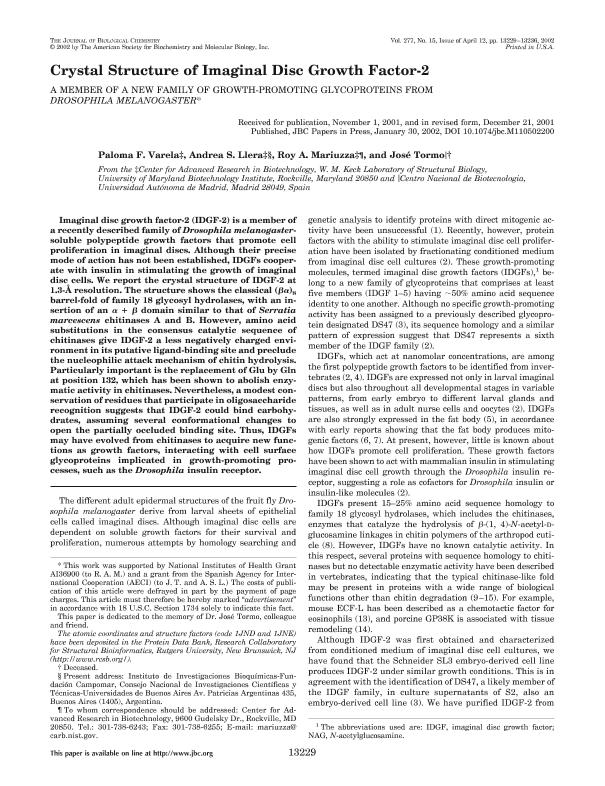Mostrar el registro sencillo del ítem
dc.contributor.author
Varela, Paloma F.
dc.contributor.author
Llera, Andrea Sabina

dc.contributor.author
Mariuzza, Roy A.
dc.contributor.author
Tormo, José
dc.date.available
2018-05-16T15:28:16Z
dc.date.issued
2002-04
dc.identifier.citation
Varela, Paloma F.; Llera, Andrea Sabina; Mariuzza, Roy A.; Tormo, José; Crystal Structure of Imaginal Disc Growth Factor-2; American Society for Biochemistry and Molecular Biology; Journal of Biological Chemistry (online); 277; 15; 4-2002; 13229-13236
dc.identifier.issn
0021-9258
dc.identifier.uri
http://hdl.handle.net/11336/45348
dc.description.abstract
Imaginal disc growth factor-2 (IDGF-2) is a member of a recently described family of Drosophila melanogaster-soluble polypeptide growth factors that promote cell proliferation in imaginal discs. Although their precise mode of action has not been established, IDGFs cooperate with insulin in stimulating the growth of imaginal disc cells. We report the crystal structure of IDGF-2 at 1.3-A resolution. The structure shows the classical (betaalpha)(8) barrel-fold of family 18 glycosyl hydrolases, with an insertion of an alpha + beta domain similar to that of Serratia marcescens chitinases A and B. However, amino acid substitutions in the consensus catalytic sequence of chitinases give IDGF-2 a less negatively charged environment in its putative ligand-binding site and preclude the nucleophilic attack mechanism of chitin hydrolysis. Particularly important is the replacement of Glu by Gln at position 132, which has been shown to abolish enzymatic activity in chitinases. Nevertheless, a modest conservation of residues that participate in oligosaccharide recognition suggests that IDGF-2 could bind carbohydrates, assuming several conformational changes to open the partially occluded binding site. Thus, IDGFs may have evolved from chitinases to acquire new functions as growth factors, interacting with cell surface glycoproteins implicated in growth-promoting processes, such as the Drosophila insulin receptor.
dc.format
application/pdf
dc.language.iso
eng
dc.publisher
American Society for Biochemistry and Molecular Biology

dc.rights
info:eu-repo/semantics/openAccess
dc.rights.uri
https://creativecommons.org/licenses/by-nc-sa/2.5/ar/
dc.subject
Glycoproteins
dc.subject
Drosophila Melanogaster
dc.subject.classification
Otras Ciencias Biológicas

dc.subject.classification
Ciencias Biológicas

dc.subject.classification
CIENCIAS NATURALES Y EXACTAS

dc.title
Crystal Structure of Imaginal Disc Growth Factor-2
dc.type
info:eu-repo/semantics/article
dc.type
info:ar-repo/semantics/artículo
dc.type
info:eu-repo/semantics/publishedVersion
dc.date.updated
2018-05-10T15:45:34Z
dc.identifier.eissn
1083-351X
dc.journal.volume
277
dc.journal.number
15
dc.journal.pagination
13229-13236
dc.journal.pais
Estados Unidos

dc.journal.ciudad
Bethesda
dc.description.fil
Fil: Varela, Paloma F.. University of Maryland; Estados Unidos
dc.description.fil
Fil: Llera, Andrea Sabina. University of Maryland; Estados Unidos. Consejo Nacional de Investigaciones Científicas y Técnicas. Oficina de Coordinación Administrativa Parque Centenario. Instituto de Investigaciones Bioquímicas de Buenos Aires. Fundación Instituto Leloir. Instituto de Investigaciones Bioquímicas de Buenos Aires; Argentina
dc.description.fil
Fil: Mariuzza, Roy A.. University of Maryland; Estados Unidos
dc.description.fil
Fil: Tormo, José. Universidad Autónoma de Madrid; España
dc.journal.title
Journal of Biological Chemistry (online)

dc.relation.alternativeid
info:eu-repo/semantics/altIdentifier/url/http://www.jbc.org/content/277/15/13229.long
dc.relation.alternativeid
info:eu-repo/semantics/altIdentifier/doi/http://dx.doi.org/10.1074/jbc.M110502200
Archivos asociados
